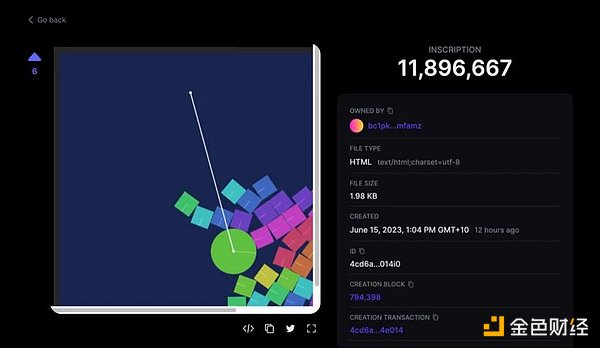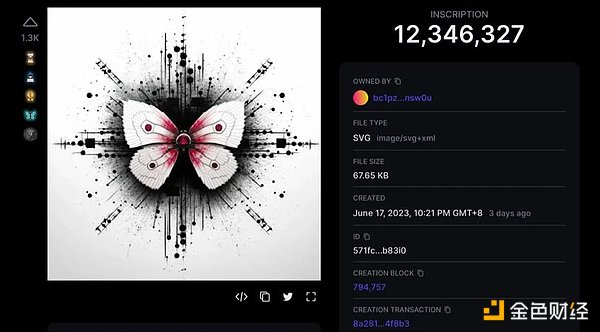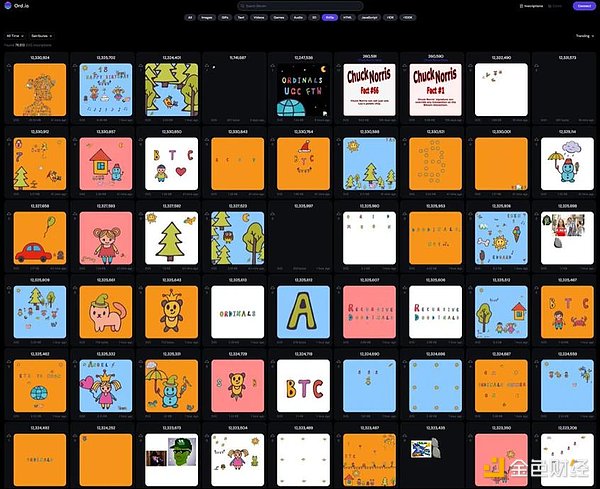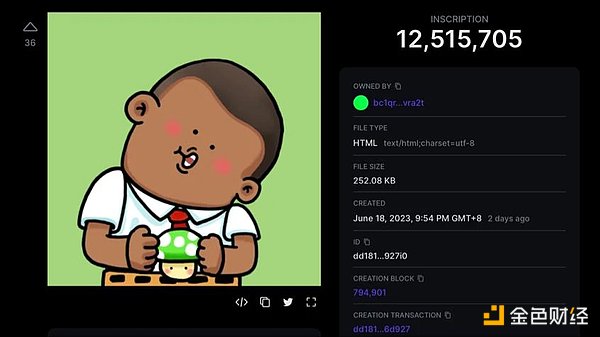Original author: Mia, ChainCatcher
With the continued popularity of the Bitcoin on-chain protocol Ordinals, innovations based on the Ordinals protocol are emerging one after another, and more and more development teams and developers are joining this innovation revolution.
Recently, Bitcoin inscriptions have a new story. Raph, the new chief developer of the Bitcoin protocol Ordinals, recently merged the “recursive inscriptions” of the number 2167 proposed by the creator of the Bitcoin protocol Ordinals, Casey Rodarmor, on Github into the Ordinals protocol, and finally updated the recursion in version 0.6.2. The concept of recursive inscriptions was born. This is a new way of engraving inscriptions that has self-referential properties, that is, recursive inscriptions allow the use of special syntax to request the content of other inscriptions. In the previous way of engraving, each inscription was independent and had no connection with other inscriptions. This expands more possibilities for inscriptions and greatly reduces their transaction fees.
Shortly thereafter, the first interactive recursive experimental inscription “Recursive Playground” experience version rose to the top of the homepage on the Bitcoin inscription information platform Ord.io. When users click on the inscription, they can interact with it using the mouse, similar to an unpacking game. This means that NFT inscriptions have evolved from being viewable by users in only one direction to now being interacted with in real-time using a mouse.
- Account abstraction in-depth analysis: Who can handle the next billion-level users?
- Delphi Digital’s interpretation of Maverick: What is the secret behind its trading volume ranking among the top DEXs on Ethereum?
- Top 5 Projects Invested by Binance Labs in 2023
From “static inscriptions” to “recursive” and now to “real-time interactive” feedback, the narrative of the Bitcoin ecosystem is becoming more dynamic and imaginative. “Recursive inscriptions” may be becoming a new ecological trend, and “interactive” will give NFT inscriptions more new gameplay.
What are “recursive inscriptions”?
According to the interpretation of the well-known KOL Leonidas of Ordinals, “Recursive inscriptions” are a new way of engraving on the blockchain that allows inscriptions to reference and call each other, breaking the awkward situation where each inscription was independent and unconnected in the past, and opening up the possibility of free combination through its composable properties. Simply put, recursive inscriptions are an inscription requesting the content of other inscriptions.
By adopting the “recursive inscription” as the inscription method, the inscription requests the content of other inscriptions using special syntax “/- /content/:inscription_id”, users can create inscriptions on the Bitcoin chain with less code, lower inscription capacity, and lower cost, and achieve more complex functions.
Leonidas explained that instead of inscribing 10,000 JPEG files individually for the PFP collection (which would be very expensive), it would be better to extract 200 features from the collection, and then request these 200 features through the new inscription syntax, combining them to make 10,000 inscriptions, each of which uses only a small amount of code to request features and combine them to present images.
In fact, recursive inscriptions use special ID syntax to use code to find the corresponding elements that already exist on the chain and then combine them, without uploading and storing all the inscription content, so the code volume is very small, which breaks through the limit of 4 MB in Bitcoin block size for inscription size, greatly reduces the cost, and brings more ideas to the Bitcoin chain.
Specifically, in the past, if you wanted to create 10,000 inscriptions for a PFP collection, you had to upload 10,000 different images, which would cost more if the images had different clarity and occupied different inscription space. Now, with recursive inscriptions, you only need to upload key elements such as patterns, characters, accessories, and so on needed for the PFP collection, and use special ID syntax to call these elements. The corresponding elements that already exist can be combined and spliced to display them as images, without uploading the entire image.
The First Interactive Recursive Inscription Recursive Playground

“Recursive Playground” is the first interactive recursive inscription NFT project. As shown in its beta version, users only need to drag the mouse lightly to change the state of the screen. It turns inscription NFT from static and only viewable to dynamic and interactive, allowing collectors to become co-creators and create their own works based on this.

In the “Recursive Playground”, the unique artistic works created in real-time by the collision of personal inspiration and computer interaction are interactive art.
Currently, the “Recursive Playground” project is still somewhat mysterious and has not revealed the launch time, price, and total amount of its related NFT products. The project has only released an interactive NFT experience version and some photos.
Although the “Recursive Playground” experience version is only the debut of the “Interactive Recursive Inscription” NFT, its importance as a milestone in the NFT cannot be denied. This is not only an attempt at interaction but also a verification of possibilities. Our understanding of NFTs is no longer limited to the two-dimensional world, and the three-dimensional attributes of NFTs have been verified.
Imagine if we try to change the reaction logic behind “Recursive Playground,” and extend the click interaction limited to the mouse to gravity systems, fluid mechanics, and even time logic. Will the “Interactive Recursive Inscription” NFT have more playability? NFTs will no longer be limited to conveying visual effects through the display screen. Through mouse interaction, users can feel its existence more. Users only need to gently touch it with their fingers, and NFTs can create ripples according to pressure.
What possibilities will the “Interactive Recursive Inscription” bring to the Bitcoin Metaverse?
Let us return to the interpretation of “Recursive Inscriptions” again. As Leonidas said, due to the attributes of recursive inscriptions, “there will now be a large software package storage library for developers to build,” which will unlock powerful use cases that can never be completed under 4 MB. Just as complex software is composed of code compiled together, the software package storage library built through recursive inscriptions can also completely place complex 3D video games on the Bitcoin chain. Bitcoin will essentially become an internal Internet, and each file can request data from other files on Bitcoin. Perhaps in the near future, we can also surf the internet happily through the Bitcoin Internet.
“Recursive Inscriptions” endow NFTs with the ability to break through the 4 MB limit of the Bitcoin block size, while “Interactive Art” gives NFTs a sublimation from visual to tactile. If “Interactive Recursive Inscription” is derived to the metaverse or gaming field, will there be a type of growth NFT in the future?
Assuming that NFT is treated as a type of electronic pet or game prop, through the inscription of recursive inscriptions, the NFT can upgrade by selecting the elements it needs from the element library. Just like in current online games, characters have the attribute of growth and upgrade, and the same attribute also applies to the metaverse and gaming fields. In addition, with the infinite recursive attribute of recursive inscriptions, theoretically the element library can be compatible with any game or NFT on the Bitcoin ecosystem, making the possibility of a fully-chain game a reality. When your NFT or equipment moves freely across any game in the Bitcoin ecosystem, the true Bitcoin ecosystem metaverse will appear before your eyes.
What are the interactive recursive inscription projects?

1. Fservin: Twitter @fservin
Using basic properties and JS WebGL fluid simulators, it generates personal web pages. According to the NFT interactive experience test, users only need to drag the mouse, and the NFT can achieve various beautiful light and shadow effects according to fluid mechanics, aerodynamic logic, and other factors.

2. Speculum Aeternum Miraculum: Twitter @const_quary
By introducing mathematical equations and variables of time (block height), the color of the butterfly changes with the increase of the Bitcoin block height, achieving interaction between machines.

3. Recursive Doodinals: Twitter @rcsvio
The project provides a series of basic attributes of NFT, and players can make their own NFTs for inscription. According to the official introduction of the project, Doodinals is the first recursively created art collection by the community. Community players can make their own graffiti on io, and all element features support position, scaling, and rotation functions. The SVG files generated by DIY will be engraved on Ordinals, and each player’s graffiti will have the opportunity to be included in the collection. According to official data, there are currently more than 128 avg files engraved on Ordinals.

4. Vibeland: Twitter @vibelandwtf
The project is the first high-definition series of original 10K collections achieved through recursion. It is the first to realize the appearance of different PFP static high-definition images with a single inscription, achieving on-chain randomness. With each page refresh, a brand-new avatar will appear, with up to 10,000 images available for random selection. This was completely impossible without recursive calls and also laid the foundation for blind boxes on Bitcoin in the future.
Summary
As Recursive Playground explains, “Bitcoin is art, canvas or even a computer.” The emergence of interactive recursive inscriptions has broken the restrictions of capacity and plane for creators in the Bitcoin ecosystem. Bitcoin network has become a paradise for users to create unique SVGs, websites, and artworks, with just a gentle touch of the mouse.
Users have transformed from simple collectors to creators, and the real metaverse also requires the construction and creation of every metaverse user. Interactive inscriptions may provide another possibility for the realization of the metaverse in the future.
Currently, the first interactive recursive inscription has only been launched for a few days, and this concept has just caught people’s attention. More and more interactive inscriptions are brewing and developing. Every great technological change comes from people’s pursuit of future technology. Will interactive recursive inscriptions lead the change in the Bitcoin ecosystem, or will it be just a flash in the pan? We wait and see.
Like what you're reading? Subscribe to our top stories.
We will continue to update Gambling Chain; if you have any questions or suggestions, please contact us!